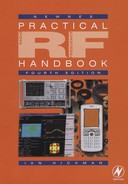Worldwide minimum external noise levels
The figures reproduced below give the minimum levels of external noise ever likely to be encountered at a terrestrial receiving site. They are thus a useful guide to the receiver designer, in that there is, in general, no point in designing a receiver to have a noise level much lower than that to be expected from a reasonably efficient aerial system. (The only exception is where, for some special purpose, a very inefficient aerial must be used, e.g. a buried antenna servicing an underground bunker.)
The figures cover the whole frequency range of radio frequencies with which this book is concerned, 10 kHz to 1 GHz, and beyond. The report from which they are reproduced also covers frequencies from 10-1Hz to 104Hz and 1 to 100 GHz.
Figures A12.1 and A12.2 are reproduced from Report 670 (Mod F) ‘Worldwide Minimum External Noise Levels, 0.1 Hz to 100 GHz’, with prior authorization from the copyright holder, the ITU. Copies of this and other reports and recommendations may be obtained from:

Figure A12.1 Fa versus frequency (104 to 108Hz). This figure covers the frequency range 104 to 108Hz, i.e., 10 kHz to 100 MHz. The minimum expected noise is shown via the solid curves and other noises that could be of interest as dashed curves. For atmospheric noise, the minimum values expected are taken to be those values exceeded 99.5% of the time and the maximum values are those exceeded 0.5% of the time. For the atmospheric noise curves, all times of day, seasons, and the entire Earth’s surface has been taken into account. More precise details (geographic and time variations) can be obtained from Report 322. The man-made noise (quiet receiving site) is that noise measured at carefully selected, quiet sites, world-wide as given in Report 322. The atmospheric noise below this man-made noise level was, of course, not measured and the levels shown are based on theoretical considerations. Also shown is the median expected business area man-made noise.
A Atmospheric noise, value exceeded 0.5% of time; B Atmospheric noise, value exceeded 99.5% of time; C Man-made noise, quiet receiving site; D Galactic noise; E Median business area man-made noise, Minimum noise level expected.

Figure A12.2 Fa versus frequency (108 to 1011Hz). The frequency range 108 to 1011Hz is covered, i.e., 100 MHz to 100 GHz. Again, the minimum noise is given by solid curves, while some other noises of interest are given by dashed curves.
A Estimated median business area man-made noise; B Galactic noise; C Galactic noise (toward galactic centre with infinitely narrow beamwidth); D Quiet sun (1/2 degree beamwidth directed at sun); E Sky noise due to oxygen and water vapour (very narrow beam antenna); upper curve, 0° elevation angle; lower curve, 90° elevation angle; F Black body (cosmic background), 2.7 K, Minimum noise level expected.
International Telecommunication Union
General Secretariat, Sales and Marketing Service
Place des Nations, CH, 1211 Geneva 20 Switzerland
Telephone: +41 22 730 61 41 (English)/+41 22 730 61 42 (French)
Telex: 421 000 uit ch/Fax: +41 22 730 51 94
X…400: S = Sales; P = itu; C - ch
Internet: [email protected]
Annex 1: ITU-R Recommendations and Reports
ITU-R Recommendations constitute a set of standards previously known as CCIR Recommendations. They are the result of studies undertaken by Radiocommunication Study Groups on:
• the use of radio frequency spectrum in terrestrial and space radiocommunication including the use of satellite orbits;
• the characteristics and performance of radio systems, except the inter-connection of radio systems in public networks and the performance required for these interconnections which are part of the ITU-R Recommendations;
• the operation of radio stations;
• the radio communication aspects of distress and safety matters.
ITU-R Recommendations are divided into series according to the subject areas they cover as follows:
| Series | Subject area |
| BO* | Broadcast satellite service (sound and television) |
| BR | Sound and television recording |
| BS* | Broadcasting service (sound) |
| BT* | Broadcasting service (television) |
| F | Fixed Service |
| IS | Inter-service sharing and compatibility |
| M* | Mobile, radiodetermination, amateur and related satellite service |
| P* | Propagation |
| RA | Radioastronomy |
| S | Fixed-satellite service |
| SA | Space applications |
| SF | Frequency sharing between the fixed-satellite service and the fixed service |
| SM | Spectrum management techniques |
| SNG | Satellite news gathering |
| TF | Time signals and frequency standard emissions |
| V | Vocabulary and related subjects |
There are currently 594 ITU-R Recommendations in force. ITU-R Recommendations are progressively being posted on TIES and will be accessible by subscribers to the ITU-R Recommendations Online Service. For further information please contact the ITU Sales Service.
*Also includes ITU-R Reports
